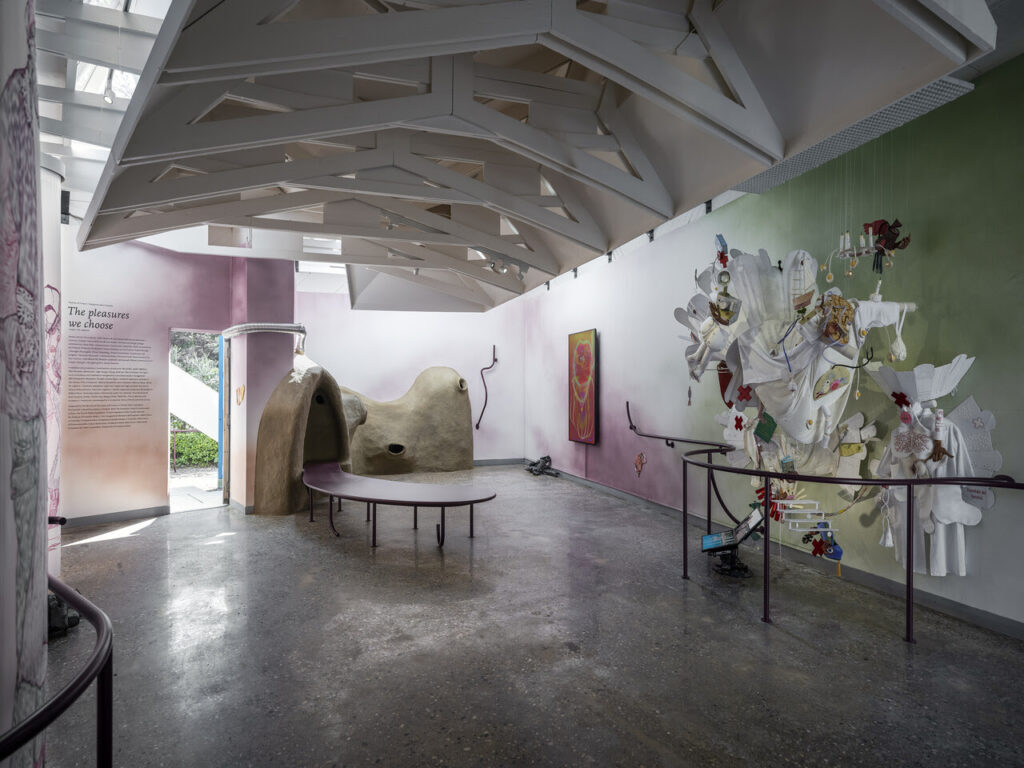60. Biennale – The pleasures we choose

Il progetto The pleasures we choose rappresenta la Finlandia alla Biennale di Venezia
Comunicato stampa
The Pavilion of Finland premieres The pleasures we choose, a new multifaceted collaboration by artists Pia Lindman, Vidha Saumya, Jenni-Juulia Wallinheimo-Heimonen, curators Yvonne Billimore and Jussi Koitela, and architectural designer Kaisa Sööt. Commissioned by Frame Contemporary Art Finland, the exhibition opens at the 60th International Venice Biennale.
Blurring the boundaries between art, architecture and social commentary, the Pavilion of Finland brings together three artists for whom art, life and activism are intertwined. Lindman, Saumya and Wallinheimo-Heimonen’s practices are acutely informed by their embodied experiences of structural, environmental and social imbalances. Articulated through a wide range of materials and processes—including drawing, needlework, sculpture and healing—their works celebrate the pleasure of the personal as a powerful means of reimagining the world as we know it.
Following her mercury poisoning, Pia Lindman experiences heightened sensitivity of the nervous system and awareness of the micro-signals within her body. She translates these subsensorial signals into images, words and colours and incorporates them into artworks that explore the nuances of different environments. In the exhibition, Lindman’s work Collectivities Cycle takes the form of an air-conditioning clay sculpture that exposes visitors to the sculpture’s organic matter and the microbes it supports. Accompanying “living digital paintings”—emerging from her participation in an online Tong Ren healing community—radiate with images that slowly shift into different bodily forms and energies.
Vidha Saumya’s works often engage with the intricate relationship between human presence and the environment. In the pavilion, Saumya’s work To all the barricades… the rumour got you is presented as a bricolage of three distinct bodies of work. Her multi-panel ballpoint pen drawing on silk cloth depicts an assembly of individuals waiting in line. Saumya explores the queue, an embodiment of time spent waiting, as an offspring of bureaucracy and trickle-down economy, and thus a universally recognised social architecture. A series of sculptures mimics the insignificant debris lining the city sidewalks, occupying the liminal space between utility and obsolescence. Lastly, a constellation of cross-stitched textiles replicate stains, patches of moisture, mould, or toxins, questioning who and what is rendered a contaminant in our natural and social climates.
How Great is Your Darkness by Jenni-Juulia Wallinheimo-Heimonen, a multi-dimensional artwork containing a textile installation, moving wheelchair sculpture and short videos, points to the hate speech people with disabilities are subjected to—particularly from within the medical and social care industries. Wallinheimo-Heimonen advocates for a shift from the medical model of disability, in which those with disabilities are typically “treated” to fit society, towards a social model, in which it is the ableist cultural attitudes that need to be transformed. The fantastical scenes she creates re-story people with disabilities as their own agents of transformation. Under the guise of humour, pearls and exquisite stitch work, her piece is thickly laced with references to the hate speech, guilt and stereotyping that people with disabilities are forced to endure.
The artists’ works are connected through architectural interventions designed by Kaisa Sööt in collaboration with the working group. The exhibition’s “access architecture” considers access and bodily needs across registers whilst encouraging new sensory experiences. These support structures materialise inside and outside of the pavilion—designed by Alvar Aalto in 1956—from a handrail extending from the Giardini’s grounds to the access tools, spatial guides and places to rest and connect inside the pavilion.
The exhibition is accompanied by a publication published by K. Verlag (Berlin) and Frame Contemporary Art Finland.
The exhibition is supported by the Ministry of Education and Culture in Finland, Kone Foundation, The Swedish Cultural Foundation in Finland, AVEK The Promotion Centre for Audiovisual Culture, The Church Media Foundation, Finnish Federation of the Visually Impaired and the Embassy of Finland in Rome.



